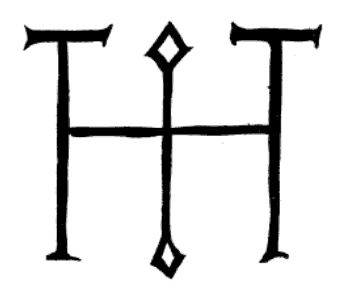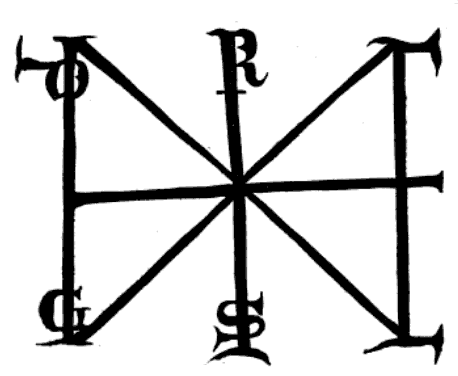Signum Manus on:
[Wikipedia]
[Google]
[Amazon]



 ''Signum manus'' (transl. ''sign of the hand'', sometimes also known as ''Chrismon'') refers to the
''Signum manus'' (transl. ''sign of the hand'', sometimes also known as ''Chrismon'') refers to the
157
ndash;202. *Ersch ''et al''., Volume 1, Issue 29 of ''Allgemeine Encyklopädie der Wissenschaften und Künste'', 1837
303
ndash;307. *Johann Christoph Gatterer, ''Elementa artis diplomaticae universalis'' (1765)
145
ndash;149 ( '' Abriß der Diplomatik'' 1798,
64
ndash;67). * Karl Friedrich Stumpf-Brentano, ''Die Wirzburger Immunitaet-Urkunden des X und XI Jahrhunderts'' vol. 1 (1874),
13
ndash;17. {{Christian crosses Signature Monograms Cross symbols Merovingian art Carolingian art


 ''Signum manus'' (transl. ''sign of the hand'', sometimes also known as ''Chrismon'') refers to the
''Signum manus'' (transl. ''sign of the hand'', sometimes also known as ''Chrismon'') refers to the medieval European
In the history of Europe, the Middle Ages or medieval period lasted approximately from the late 5th to the late 15th centuries, similar to the post-classical period of global history. It began with the fall of the Western Roman Empire an ...
practice of signing a document or charter with a special type of monogram or royal cypher. The practice is documented from at least the Merovingian period
The Merovingian dynasty () was the ruling family of the Franks from the middle of the 5th century until 751. They first appear as "Kings of the Franks" in the Roman army of northern Gaul. By 509 they had united all the Franks and northern Gauli ...
(ca. 5th century) until the 14th century in the Frankish Empire
Francia, also called the Kingdom of the Franks ( la, Regnum Francorum), Frankish Kingdom, Frankland or Frankish Empire ( la, Imperium Francorum), was the largest post-Roman barbarian kingdom in Western Europe. It was ruled by the Franks du ...
and its successors.
History
The term ''Chrismon'' was introduced inNew Latin
New Latin (also called Neo-Latin or Modern Latin) is the revival of Literary Latin used in original, scholarly, and scientific works since about 1500. Modern scholarly and technical nomenclature, such as in zoological and botanical taxonomy ...
specifically as a term for the Chi Rho monogram. As this symbol was used in Merovingian documents at the starting point of what would diversify into the tradition of "cross-signatures", German scholarship of the 18th century extended use of the term ''Chrismon'' to the entire field. In medievalist paleography
Palaeography ( UK) or paleography ( US; ultimately from grc-gre, , ''palaiós'', "old", and , ''gráphein'', "to write") is the study of historic writing systems and the deciphering and dating of historical manuscripts, including the analysi ...
and ''Diplomatik'' (''ars diplomaticae'', i.e. the study of documents or charters), the study of these signatures or sigils was known as ''Chrismologia'' or ''Chrismenlehre'', while the study of cross variants was known as ''Staurologia''.
''Chrismon'' in this context may refer to the Merovingian period
The Merovingian dynasty () was the ruling family of the Franks from the middle of the 5th century until 751. They first appear as "Kings of the Franks" in the Roman army of northern Gaul. By 509 they had united all the Franks and northern Gauli ...
abbreviation ''I. C. N.'' for ''in Christi nomine'', later (in the Carolingian period
The Carolingian dynasty (; known variously as the Carlovingians, Carolingus, Carolings, Karolinger or Karlings) was a Frankish noble family named after Charlemagne, grandson of mayor Charles Martel and a descendant of the Arnulfing and Pippi ...
) also ''I. C.'' for ''in Christo'', and still later (in the high medieval period) just ''C.'' for ''Christus''.
A cross symbol was often drawn as an invocation at the beginning of documents in the early medieval West. At the end of documents, commissioners or witnesses would sign with a ''signum manus'', often also in the form of a simple cross. This practice is widespread in Merovingian documents of the 7th and 8th centuries. A related development is the widespread use of the cross symbol on the obverse side of early medieval coins, interpreted as the ''signum manus'' of the moneyer.
The tradition of minting coins with the monogram of the ruling monarch on the obverse side originates in the 5th century, both in Byzantium and in Rome. This tradition was continued in the 6th century by Germanic kings, including the Merovingians. These early designs were ''box'' monograms. The first ''cruciform'' monogram was used by Justinian I
Justinian I (; la, Iustinianus, ; grc-gre, Ἰουστινιανός ; 48214 November 565), also known as Justinian the Great, was the Byzantine emperor from 527 to 565.
His reign is marked by the ambitious but only partly realized ''renovat ...
in the 560s. Tiberius III
Tiberius III ( gr, Τιβέριος, Tibérios), born Apsimar ( la, Apsimarus; gr, Αψίμαρος, Apsímaros),), Apsimerus and Absimerus. Many of these are likely typos or transliteration errors. was Byzantine emperor from 698 to 705AD. Lit ...
used a cruciform monogram with the letters ''R, M'' for Rome and ''T, B'' for Tiberius; Pope Gregory III
Pope Gregory III ( la, Gregorius III; died 28 November 741) was the bishop of Rome from 11 February 731 to his death. His pontificate, like that of his predecessor, was disturbed by Byzantine iconoclasm and the advance of the Lombards, in which ...
used the letters ''G, R, E, O''.
The earliest surviving Merovingian royal charters, dating to the 7th century, have the box monograms of Chlothar II
Chlothar II, sometime called "the Young" (French: le Jeune), (May/June 584 – 18 October 629), was king of Neustria and king of the Franks, and the son of Chilperic I and his third wife, Fredegund. He started his reign as an infant under the ...
and Clovis II
Clovis II (633 – 657) was King of Neustria and Burgundy, having succeeded his father Dagobert I in 639. His brother Sigebert III had been King of Austrasia since 634. He was initially under the regency of his mother Nanthild until her ...
. Later in the 7th century, the use of royal monograms was abandoned entirely by the Merovingian kings; instead, royal wax seals were first attached to the documents, and the kings would sign their name in full.
The ''signum manus'' in the form of a modified cross symbol first appears in charters of both Frankish Gaul and Anglo-Saxon England in the late 7th and early 8th century. Charlemagne
Charlemagne ( , ) or Charles the Great ( la, Carolus Magnus; german: Karl der Große; 2 April 747 – 28 January 814), a member of the Carolingian dynasty, was King of the Franks from 768, King of the Lombards from 774, and the first Holy ...
first used his cruciform monogram, likely inspired by the earlier papal monograms, in 769, and he would continue to use it for the rest of his reign. The monogram spells ''KAROLVS'', with the
consonants ''K, R, L, S'' at the ends of the cross-arms, and the vowels ''A, O, V'' displayed in ligature at the center.
Louis the Pious
Louis the Pious (german: Ludwig der Fromme; french: Louis le Pieux; 16 April 778 – 20 June 840), also called the Fair, and the Debonaire, was King of the Franks and co-emperor with his father, Charlemagne, from 813. He was also King of Aqui ...
abandoned the cross monogram, using again a H-type or box monogram.Garipzanov (2008:182)
See also
*Christogram
A Christogram ( la, Monogramma Christi) is a monogram or combination of letters that forms an abbreviation for the name of Jesus Christ, traditionally used as a Christian symbolism, religious symbol within the Christian Church.
One of the oldes ...
*Rota (papal signature)
The ''rota'' is one of the symbols used by the pope to authenticate documents such as papal bulls. It is a cross inscribed in two concentric circles. Pope Leo IX was the first pope to use it.
The four inner quadrants contain: " ''Petrus''", ...
* Royal cypher
*Tughra
A tughra ( ota, طغرا, ṭuġrā) is a calligraphic monogram, seal or signature of a sultan that was affixed to all official documents and correspondence. Inspired by the tamgha, it was also carved on his seal and stamped on the coins minted du ...
References
*Ildar H. Garipzanov, Chapter 4 in ''The Symbolic Language of Royal Authority in the Carolingian World (c.751-877)'' (2008)157
ndash;202. *Ersch ''et al''., Volume 1, Issue 29 of ''Allgemeine Encyklopädie der Wissenschaften und Künste'', 1837
303
ndash;307. *Johann Christoph Gatterer, ''Elementa artis diplomaticae universalis'' (1765)
145
ndash;149 ( '' Abriß der Diplomatik'' 1798,
64
ndash;67). * Karl Friedrich Stumpf-Brentano, ''Die Wirzburger Immunitaet-Urkunden des X und XI Jahrhunderts'' vol. 1 (1874),
13
ndash;17. {{Christian crosses Signature Monograms Cross symbols Merovingian art Carolingian art